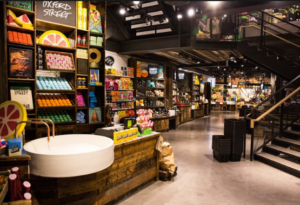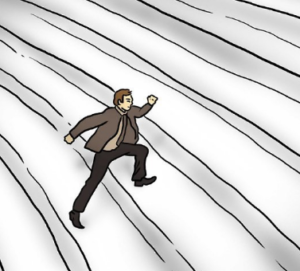Are you struggling with finding new areas of profitable growth? It may be some comfort to know you’re not alone. And time and again, we’ve seen organizations make the same mistakes when looking for those opportunities. Surprise, surprise! They are ignoring exploring retail innovation.

As a result, they tend to botch mergers and acquisitions. They search frantically for “blue oceans” of uncontested market space. What they should be doing, instead, is analyzing their core business for growth opportunities.
In the past, most retail innovations focused primarily on efficiency to mass-market opportunities. Ongoing innovations in technology improvements will continue to improve efficiency. But future retail innovations will be more customer-facing.
Retailers will address the unique needs and desires of individual consumers. They will provide a more rewarding and memorable shopping experience.
These companies will innovate around new formats and distribution models, products, and service offerings. Marketing and customer communications will continue to improve.
Subsequently, we have identified many innovation opportunity areas. These provide tremendous potential for creating new consumer benefits and stakeholder economic value.
Innovative retailers have a huge growth opportunity
Ecommerce-first retail expansion is like testing your abilities at a $10 table before you muster the courage to lay some serious money down.
As a result, your online store can turn a potential all-in play into a simple check.
You might still stuff it up. It’s still challenging, uncertain, and slightly daunting. But you dramatically reduce the potential risk if everything goes belly-up.
The ‘fail-fast’ mentality lends itself to the global eCommerce question.
Nimble and assertive startups are widening their reach and diversifying their revenue streams. However, more conservative retail brands watch on from the sidelines.
Before online shopping, the retailer’s plunge into overseas markets was fraught with danger.
You needed a whole bunch of expensive, time-consuming accompaniments:
- In-depth market research
- Physical store/s in an unknown location
- Overheads from day one
- A new home-country management team (or a costly relocation of existing staff)
- A collection of new employees to train and manage
- New culture, system, and legislation to understand
- Instant revenue to pay the bills
You’re all-in at this point. If the cards don’t fall in your favor, you’re in serious financial strife.
It can all go from hero to zero very quickly though.
Ecommerce brings a luxurious calm to the equation.
International expansion with an online store is faster, cheaper, and easier.
Better than anything – there’s no extreme pressure from costly overheads to make money immediately. If you launch your site, and demand is slow – you have the time to generate more awareness. Alternatively, you can abort your mission without a massive net loss.
The “what’s the worst that can happen?” attitude can be a positive here.
Try a new market
If it fails, at least you gave it a burl.
If it succeeds, the growth potential exponentially outweighs your loss.
Help me choose
More products, brands, retailers, and shopping formats are introduced to consumers every year. At the same time, technology has resulted in an explosion of information. This includes inaccurate and irrelevant information.
Consumers are faced with too many choices and information overload. And as well as more complex products and a lack of knowledgeable sales assistance. Therefore many consumers are struggling to make smart choices and are looking to retailers for help.
Catch a wave
Successful marketers ride the waves created by demographic, societal, economic, and technological trends. These “green space” opportunities represent emerging growth patterns in the market.

Companies that apply innovative thinking to a growth market opportunity can generate even stronger growth and financial performance. New products, new services, new retail concepts as well as new business models maximize these trends.
Exploring retail innovation … solve my problem
Retail problem-solvers understand what the consumer is trying to accomplish by looking downstream at his or her ultimate goal. For example, innovative home improvement retailers understand that the consumer doesn’t want to buy a drill.
The consumer wants to make a hole in order to build a deck. Looking even further downstream, she/he wants to build a deck to entertain family and friends.
This consumer-centric approach results in opportunities to add value to the shopping experience by doing more for the consumer. Often, this requires adding services, information, and support to the product mix in order to provide a complete solution.
It may also mean offering additional product categories or adopting new approaches to marketing and merchandising, These reflect a better understanding of the shopper’s ultimate goal. In every case, it means getting away from a transaction mentality and focusing on customer relationships.
Retailers that have established relationships with customers have bonds of trust that create innovative opportunities to extend the relationship further.
Exploring retail innovation … help me connect
Consumers have a fundamental desire to connect with one another, and technology is facilitating the exchange of ideas, information, and opinions. New types of social networks foster community among consumers who share a common passion or interest.

Marketers can forge stronger relationships with these consumers and earn their patronage by helping them connect. These connections matter to them and help by responding to their emotional as well as their physical needs.
Exploring retail innovation … do it my way
Shopping is becoming increasingly individualistic. This is being driven by the growing diversity of the consumer marketplace, technology enablers, and the consumer’s desire for greater influence, control, and uniqueness.
In this new environment, the retail power structure has permanently shifted from sellers to buyers. Innovative retailers will look for ways to provide more unexpected gratification to shoppers. This lets them express themselves in unique ways. And what is more unique than “me”?
But, can marketers really seek out the desires of individual consumers and do only and exactly what each one needs or wants? For the most part, customizing each order to each demand point will remain outside the boundaries of economic feasibility. Instead, the goal will be better matching the market to the consumer.
The Internet enables this process by providing greater accessibility to more information and more options. This along with the ability to customize the shopping process to better meet shoppers’ specific needs.
Speed it up
Consumers value what is most scarce, and time is at the top of the list for many. They want it fast (speed up the shopping process). Consumers want it now (immediate gratification). They want it first (latest and greatest).
Exploring retail innovation … e
As busy consumers turn to the Internet to satisfy more of their shopping needs, store retailers will focus more intently on providing better experiences. Experiences that can be gained only by being there. Individual retailers—even category killers—may not be able to own a merchandise category, but they can own a buying experience.
The decision to create a customer experience shifts the focus from what moves product to what moves people. Experiences are more than entertainment, education, or interaction; they engage customers in a memorable and meaningful way.
In The Experience Economy, authors Pine and Gilmore discuss the opportunity for companies to script and stage experiences. Those that create value that exceeds the value of the goods and services used to create the experience.
The authors urge companies to look beyond traditional pricing factors like time and cost and consider charging for the value of the experience.
Goods and services say, Pine and Gilmore, are no longer enough. Experiences are the basis for future economic growth.
Make it easy
Ease-of-use is vital to the success of the retail shopping experience. The innovative process, service, and design solutions that are simple, intuitive, and in tune with shoppers’ needs. These solutions—along with new technology tools— can save consumers time and effort.
Easier and more rewarding customer experience will boost sales and enhance customer satisfaction and loyalty.
Exploring retail innovation … do it for me
Another way to solve my problem is to do it for me.
Demographic shifts and lifestyle changes—along with growing product complexity—are steadily driving former DIY consumers into the do-it-for-me (DIFM) market. This market can be for everything from home improvement and automobile maintenance to cooking and cleaning.
Retailers are responding to consumers’ increasing do-it-for-me demands with innovative new services and conveniences.
Come to me
In the old days, consumers made the pilgrimage downtown from miles around in order to shop. Then malls were created, and shoppers flocked to these huge centers as the main shopping hub.
More recently, many retailers have been moving into neighborhoods to be closer to where their customers live. What’s next? In my home, in my car, at my workplace.
New distribution models are springing up as retailers take the show on the road and reach out to consumers wherever they are.
Emerging markets present the best long term opportunity
You need to do some solid research before you dive right into international waters.
Analyze the demand and competition in any potential new market. You might even like to run a pilot or beta program to test a few key products before you commit significant investment.
It’s critical you find the right nation/s to ensure success. The obviously established markets in North America and Europe might not be the best strategic options.
Here’s some super valuable advice from Bigcommerce:
“Online shoppers from smaller countries are probably more likely to make international purchases, and they’ll likely spend in larger international markets like the U.S., Canada, and Australia.”
While the dollars and demand might exist in the US, UK, and Canada – these markets are the high rollers.
It’s a tough room.
You might find it a little intimidating taking on the Amazon/eBay/Asos of your industry.
(If Amazon played poker, I imagine this is what he or she would look like.)
It will be harder to muscle in from a low base. Generating awareness and acquiring customers could be challenging, and costly (of course, the glass-half-full retailer knows a larger market means you need a smaller slice of the pie).
In contrast, it may be easier to establish traction in less established online retail markets (particularly those isolated nations poorly serviced by global powerhouses).
Places like New Zealand, Scandinavia, South Africa have developed markets, with a high proportion of people conditioned to buying online.
Newer emerging markets like China, India, Brazil, and Indonesia present more of a cultural and logistic challenge, but the growth potential is enormous, and the competition is underdeveloped.
If you play your cards right at these new tablets, the payoff could be enormous.
If you take on the heavyweights high rollers, things could be a whole lot more difficult.
The bottom line
The truth is that there is no one truth to innovation. Not IBM, Google nor Amazon has hit on the “right” way to innovate, but they have found the right way for them. It is how those practices have become so deeply embedded into the fabric of their organizations over time that makes the difference.
If you want to innovate, you need to find your own path.
E-commerce has certainly revolutionized the way we shop, but brick-and-mortar stores are far from dead.
Increasingly, online retailers have begun opening physical stores for the first time, which signals that there may be a return to real-world shopping – only this time, reinvented for the digital age.
